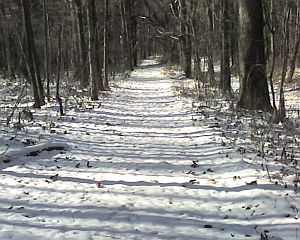
24 November 2008
I like to hike in winter when it’s not too cold. The woods are open after the leaves have fallen and I can see new places to explore. Even better, I can go off trail without worrying I’ll get lost because I can follow my own tracks in the snow back to the car.
Yesterday I explored Porters Cove at Moraine State Park. Most of the time I stayed on marked trails (shown here) but I was tempted to follow someone else’s footprints into the woods. Where were they going? And why?
The tracks looked to be a day old and they went both ways – out and back – so I knew I wouldn’t encounter the person if I followed them. There’s no hunting on Sundays but I put on my blaze orange vest and hat just in case and set off.
From the start the tracks wove in and out. The man was hunting. Perhaps he too was tracking something but what I could not tell. His wanderings were tiring me so I made my own straight trail. That’s when I discovered something the man didn’t see – a coyote’s den in the hollow of a huge old oak. The animal had left the den at least a day before the man walked by. Eastern coyotes survive by carefully avoiding human contact.
As I examined the coyote’s tracks I smelled a skunk. What’s this?! Just a patch of skunk cabbage I’d inadvertently crushed underfoot. Skunk cabbage not only survives the winter but is one of the first to sprout in the spring because it can generate inner temperatures 35 degrees warmer than the air. Each plant in this patch had melted the snow around it.
I resumed the hunter’s trail. At this point he was walking straight through the woods and had made the trip twice. I paused at the edge of a copse of trees. For some reason I didn’t want to proceed. I looked ahead and saw his tree stand erected for deer season. Best not to go near it. Interesting that my intuition said “stop” before I got there.
On the way back I took a detour to walk near the lake. As I approached I heard a hissing, pinging sound. The lake had started to freeze and a thin layer of clear ice rolled on top of the waves. The ice was “singing.”
Way cool.
(photo by Kate St. John)